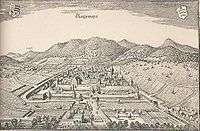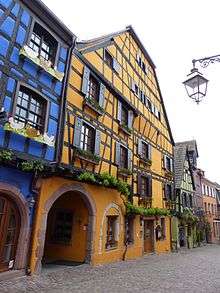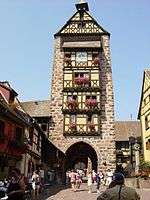Riquewihr
| Riquewihr | ||
|---|---|---|
| Commune | ||
|
Main street | ||
| ||
 Riquewihr | ||
|
Location within Grand Est region  Riquewihr | ||
| Coordinates: 48°10′02″N 7°17′52″E / 48.1672°N 7.2978°ECoordinates: 48°10′02″N 7°17′52″E / 48.1672°N 7.2978°E | ||
| Country | France | |
| Region | Grand Est | |
| Department | Haut-Rhin | |
| Arrondissement | Colmar-Ribeauvillé | |
| Canton | Sainte-Marie-aux-Mines | |
| Intercommunality | Ribeauvillé et environs | |
| Government | ||
| • Mayor (2001–2008) | Jean Buttighoffer | |
| Area1 | 17.04 km2 (6.58 sq mi) | |
| Population (2006)2 | 1,308 | |
| • Density | 77/km2 (200/sq mi) | |
| Time zone | CET (UTC+1) | |
| • Summer (DST) | CEST (UTC+2) | |
| INSEE/Postal code | 68277 /68340 | |
| Elevation |
230–936 m (755–3,071 ft) (avg. 295 m or 968 ft) | |
|
1 French Land Register data, which excludes lakes, ponds, glaciers > 1 km² (0.386 sq mi or 247 acres) and river estuaries. 2 Population without double counting: residents of multiple communes (e.g., students and military personnel) only counted once. | ||
Riquewihr (French pronunciation: [ʁikviʁ]; German: Reichenweier ![]() listen ) is a commune in the Haut-Rhin department in Grand Est in north-eastern France.
listen ) is a commune in the Haut-Rhin department in Grand Est in north-eastern France.
A popular tourist attraction for its historical architecture, Riquewihr is also known for the Riesling and other great wines produced in the village. Riquewihr looks today more or less as it did in the 16th century. It is officially one of the most beautiful villages in France, or Les plus beaux villages de France
Geography

Riquewihr is only 11 kilometres (7 mi) from Colmar and minutes from other Alsatian villages such as Ribeauvillé, Hunawihr, Eguisheim or Kaysersberg.
History

Originally the property of the Dukes of Württemberg, the town was converted to Protestantism in the 16th century. Historically, Riquewihr served as a Winzerdorf or "wine village" as a trading hub for Alsatian and German wine.
Sights

Riquewihr was one of the few towns in the area not to be badly damaged during World War II. The town is surrounded by its medieval fortifications and is overlooked by a castle from the same period that is today a museum.
There is a museum about Alsace during World War II and a torture chamber (La salle de torture).
The village is a member of the Les Plus Beaux Villages de France ("The most beautiful villages of France") association.
See also
References
External links
| Wikimedia Commons has media related to Riquewihr. |
.svg.png)